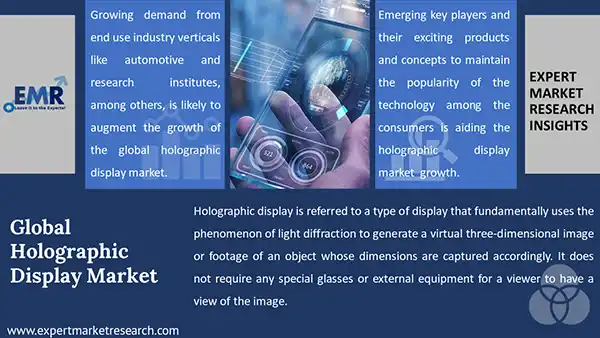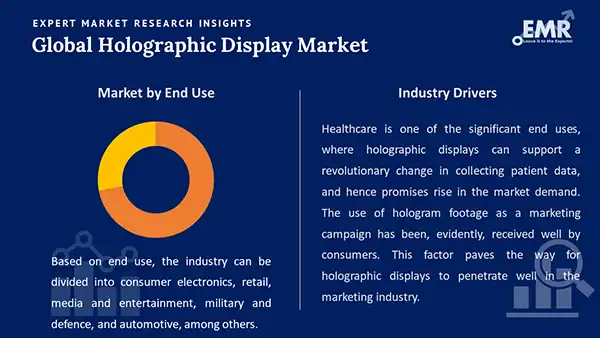
Consumer Insights
Uncover trends and behaviors shaping consumer choices today
Procurement Insights
Optimize your sourcing strategy with key market data
Industry Stats
Stay ahead with the latest trends and market analysis.
Trending Now



The global holographic display market reached a value of nearly USD 2.83 Billion in 2024. The market is assessed to grow at a CAGR of 29.30% during the forecast period of 2025-2034 to attain a value of around USD 36.96 Billion by 2034. The market growth can be attributed to the robust growth of the medical and healthcare sectors, the increasing integration of voice-activated or gesture-based controls into holographic displays, surging rollouts of 5G networks, and technological advancements and innovations.
Base Year
Historical Year
Forecast Year






Value in USD Billion
2025-2034
Holographic Display Market Outlook
*this image is indicative*

Read more about this report - REQUEST FREE SAMPLE COPY IN PDF
The holographic display market development is being driven by a wide range of practical uses of holographic displays in different sectors, including engineering, medical technology, pharmaceuticals, food and beverages, telecommunications, and entertainment, among others. The use of holograms in the marketing field has proven to be effective owing to their interactive superiority, which is conveyed better than any other marketing strategy.
The robust growth of the medical and healthcare sectors is boosting the holographic display market revenue. In surgical planning, medical imaging, and patient education, holographic images enable doctors to interact with 3D visualisations of medical imaging data such as MRIs, CT scans, and ultrasound images. Moreover, the rising demand for personalised treatment options is fuelling the usage of holographic displays to enable doctors to create patient-specific 3D models based on their unique anatomical structures. Besides, holographic displays are used in medical schools and hospitals to improve medical training and education.
Holographic displays are integrated into educational settings to visualise complex subjects such as chemistry, biology, and history in interactive, three-dimensional formats. In corporate training, holograms facilitate hands-on stimulation for sectors such as medicine, engineering, and aviation, among others.
There is a rising integration of voice-activated or gesture-based controls into holographic displays to enable users to offer more intuitive and hygienic interfaces, especially in retail, healthcare, and public information systems. In the forecast period, advancements in sensor-based gesture recognition to enable users to manipulate holograms with hand movements are expected to aid the holographic display market.
Holographic displays are increasingly used in visualising digital twins in sectors such as architecture, manufacturing, and infrastructure to stimulate real-world conditions in real-time and enable better predictive maintenance and decision making. Advancements in technologies are anticipated to make holographic displays as essential tools for improving decision making, lowering downtime, and enhancing efficiency across different industries.
Advancements in holographic display technologies; expansion of 5G networks; technological advancements; and increasing focus on cost reduction are favouring the holographic display market expansion.
Advancements in holographic display technologies are providing lucrative holographic display market opportunities. Key players are focusing on innovations to develop clearer and more lifelike holographic videos and images, boosting the usage of holographic displays in sectors like interactive advertising, medical imaging, and entertainment. The development of holographic displays that can render high-fidelity and natural-looking holograms with enhanced depth, detail, and texture, especially in augmented and virtual reality applications, is also aiding the market. Besides, there is an increasing integration of augmented and virtual reality (AR/VR) with holographic displays to improve immersion, realism, and interaction across a variety of sectors like healthcare, gaming, and education.
The expansion of 5G networks is shaping the holographic display market trends and dynamics. In 2023, the adoption of 5G networks worldwide reached 1.76 billion. 5G technology offers low-latency performance and real-time and high-speed data transfer, making it possible to stream complex holographic data without lag while enhancing the user experience. The rapid rollout of 5G networks is also facilitating the delivery of high-quality holograms to mobile devices without the need to tether to powerful desktop computers for use in applications like healthcare, remote work, retail, and advertising. As holographic displays used in virtual reality (VR) and augmented reality (AR) require the transmission of large amounts of data in real-time, the requirement for 5G ultra-fast data speed to enable seamless streaming of high-resolution holographic content without lag or buffering is surging.
Artificial intelligence (AI) and machine learning (ML) are increasingly integrated into holographic displays to make them more responsive and interactive. Such technologies can optimise the display of holograms on different devices, adjusting factors such as resolution, lighting, and viewer perspective in real time. AI algorithms can also automatically optimise and generate 3D holographic content from 2D images or videos while reducing costs and time associated with manually creating holograms. AI-powered chatbots and voice assistants are also increasingly integrated with holographic displays, enabling users to interact with holographic content through voice commands. Moreover, the increasing deployment of AI-powered holographic display technologies in different sectors like manufacturing and autonomous systems is revolutionising the holographic display market landscape.
Advancements in manufacturing techniques, including more efficient use of materials and better projection technologies, aimed at reducing production costs are propelling the holographic display market expansion. The development of newer methods, such as OLED integration and laser-based holography, to enable the production of holographic displays at a lower cost, making them more accessible to various sectors, is aiding the market. Moreover, manufacturers are integrating holographic displays with technologies such as LCD and LED screens to develop hybrid solutions that offer the benefits of holography without the high costs of fully holographic systems. Various companies are adopting cloud-based holographic solutions and offering holographic displays on a subscription basis, lowering upfront costs of acquiring the hardware and making the technology accessible to smaller businesses.
Advancements in holographic display technologies are driving the holographic display market growth, with key players focusing on creating clearer, lifelike holograms for applications in advertising, medical imaging, and entertainment. These improvements, especially in augmented and virtual reality (AR/VR), enhance depth, texture, and interaction, expanding use cases in sectors like healthcare, gaming, and education. The rollout of 5G networks is also shaping the market by enabling real-time, high-speed data transfer, allowing seamless streaming of complex holographic content to mobile devices. This is particularly important for AR/VR applications that require large data transfers. Additionally, the integration of artificial intelligence (AI) and machine learning (ML) into holographic displays is improving interactivity and personalisation. AI can optimise hologram display quality and automatically generate 3D content, while AI-powered chatbots and voice assistants are enhancing user engagement. These innovations are opening new opportunities in diverse sectors such as manufacturing, autonomous systems, and remote work.
The growth of the holographic display industry can be challenged by the high costs of developing and manufacturing advanced technologies. The manufacturing of holographic displays requires costly hardware, specialised materials, and advanced technology, which limits their adoption, especially among small businesses.
Holographic displays can be limited by various technical constraints, such as viewing angle and resolution, and achieving consistent high-resolution and lifelike holograms across different viewing angles can be challenging. Such displays also require specialised hardware and software, creating compatibility issues with existing technologies and solutions.

Read more about this report - REQUEST FREE SAMPLE COPY IN PDF
The EMR’s report titled “Global Holographic Display Market Report and Forecast 2025-2034” offers a detailed analysis of the market based on the following segments:
Market Breakup by End Use
Market Breakup by Region
By End Use Insights
As per the holographic display market analysis, the mainstreaming of holographic displays and their incorporation in consumer electronics, such as tablets, AR glasses, and smartphones are aiding the market. The rising demand for immersive and engaging content is prompting customer electronics companies to incorporate holographic displays and provide users with 3D viewing experiences without the need for additional glasses or equipment.
In the retail sector, holographic displays are used to highlight specific products and create an immersive experience, improving the shopping experience. Retailers are also leveraging holographic displays for virtual try-on experiences, enhancing the online shopping experience, enabling more interactive decision-making, and reducing returns. In January 2023, H&M installed a Proto hologram display in its Williamsburg store, in Brooklyn, New York, offering promotional campaigns for H&M Move (an athletic clothing line).
As per the holographic display market analysis, holographic displays are used in film and television production to facilitate special effects, virtual sets, and interactive visualisations to enhance the overall experience. Themes and museums are adopting holographic displays for immersive exhibits and attractions, enabling visitors to interact with 3D representations of artefacts, historical figures, or futuristic concepts.
Meanwhile, holographic displays enable military personnel to view interactive and real-time maps of urban environments, battlefields, and tactical operations. They also facilitate immersive training simulations, enabling soldiers to practice combat scenarios, equipment handling, and decision-making in a virtual, 3D setting.
Conversely, automakers are integrating holographic displays into dashboards and heads-up displays (HUDs), offering speed ratings, augmented reality (AR) navigation, and real-time alerts in three dimensions. The growing focus on in-vehicle safety systems and driver assistance and the increasing customer demand for interactive in-car experiences are boosting the holographic display market value.
North America Holographic Display Market Overview
The holographic display demand growth in North America is being driven by the rising demand for interactive and immersive experiences in sectors such as healthcare, design, healthcare, and education. The retail and advertising sectors of the United States and Canada are using holographic displays for developing interactive advertisements, showcasing products, and boosting customer engagement. In December 2021, Diageo launched a 3D 4K AI holographic display for the Johnnie Walker Scotch whisky brand in Toronto, Canada, enabling the brand to create a stronger connection with customers.
Europe Holographic Display Market Dynamics
Advancements in holographic display technologies aimed at creating high-resolution and dynamic displays that can be electronically controlled are revolutionising the Europe holographic display market landscape. Increasing research and development activities aimed at boosting the usage of polymer-based and flexible materials that can lead to the creation of portable, lightweight, and flexible holographic display devices are further driving the market. In October 2021, researchers at the University of Stuttgart in Germany introduced a new approach to dynamic holographic displays, based on electrically switchable plasmonic nanoantennas made from conductive metallic polymers. Besides, key players in the market are increasingly attempting to deploy holographic display technologies in the automotive sector to project critical driving information directly on the dashboard or windshield and create 3D representations of routes and surroundings. In September 2024, the HÜBNER Group, in collaboration with ZEISS Microoptics, announced that it was developing holographic display technology for window systems in buses and trains, offering passengers enhanced comfort and convenience in their usage of public transport.
Asia Pacific Holographic Display Market Trends
The holographic display forecast demand is being fuelled by the robust growth of sectors like media and entertainment, retail, and consumer electronics in the Asia Pacific. Under their digital infrastructure and smart city initiatives, governments in countries such as South Korea, Japan, and China, among others, are increasingly investing in research and development (R&D) activities to advance holographic technology. Such countries are also at the forefront of developing advanced holographic displays with enhanced interaction, cost-effectiveness, and energy efficiency, boosting their usage in both consumer and commercial applications.
Latin America Holographic Display Market Outlook
Retailers in Latin America are increasingly integrating holographic displays into their stores, virtual fitting rooms, and advertising campaigns to improve customer experiences and offering an engaging shopping experience. Educational institutions in the region are also adopting holographic displays to provide an interactive and immersive learning experience to customers. In addition, the flourishing automotive sector is utilising holographic displays for augmented reality (AR) dashboards to show essential information like speed, navigation, and safety warnings to improve convenience and safety.
Middle East and Africa Holographic Display Market Overview
As per the holographic market display market regional analysis, the Middle East and Africa is adopting holographic technology for concerts and live performances. In the region, theme parks, museums, and cultural exhibitions are integrating holographic displays to provide interactive experiences to visitors and tourists. The increasing development of smart cities in the region is surging the use of holographic displays to visualise infrastructure projects, urban projects, and city models is aiding the market.
Key holographic display market players are investing in the development of advanced holographic display technologies such as volumetric displays, autostereoscopic displays, and light field displays for end-use sectors such as automotive, consumer electronics, medical, and entertainment. Holographic display companies are also attempting to make holographic displays more consumer-friendly and accessible and developing holographic displays for mobile and wearable applications.
Provision Holding, Inc., headquartered in California, United States, is a technology company that offers augmented reality (AR) and holographic display solutions for use in the commercial sector. The company’s solutions enable businesses to incorporate high-definition 3D holograms into their physical spaces, offering a more immersive experience to customers.
Looking Glass Factory Inc., headquartered in New York, United States, is a technology company that specialises in holographic display technology. Through its 3D holographic displays, the company aims to bridge the gap between 3D digital content and physical and real-world environments.
RealView Imaging Ltd., headquartered in Israel, is a prominent medical technology company that offers holographic display solutions for use in the medical sector. Its solutions can display medical data like MRIs, CT scans, and ultrasound images in three-dimensional holograms. Some of its key solutions and services are Holoscope™, Holo-Doctor™, and HoloMed™, among others.
*Please note that this is only a partial list; the complete list of key players is available in the full report. Additionally, the list of key players can be customized to better suit your needs.*
Other key players in the holographic display market are Animmersion UK Ltd., Kino-Mo Ltd., and Shenzhen SMX Display Technology Co. Ltd., among others.
*While we strive to always give you current and accurate information, the numbers depicted on the website are indicative and may differ from the actual numbers in the main report. At Expert Market Research, we aim to bring you the latest insights and trends in the market. Using our analyses and forecasts, stakeholders can understand the market dynamics, navigate challenges, and capitalize on opportunities to make data-driven strategic decisions.*
Get in touch with us for a customized solution tailored to your unique requirements and save upto 35%!
In 2024, the market reached an approximate value of USD 2.83 Billion.
The market is projected to grow at a CAGR of 29.30% between 2025 and 2034.
The major market drivers include the robust growth of the automotive and electronics sectors, the rising popularity of holographic technology in automobiles, and increasing use of holographic displays in medical imaging.
Technological advancements and innovations, the divers use of holographic displays in diverse end-use sectors, and the deployment of holographic displays as effective marketing strategy are the key trends aiding the market growth.
The major regions in the market are North America, Latin America, the Middle East and Africa, Europe, and the Asia Pacific.
The significant end uses of the product are consumer electronics, retail, media and entertainment, military and defence, and automotive, among others.
The major players in the market are Provision Holding, Inc., Looking Glass Factory Inc., RealView Imaging Ltd., Animmersion UK Ltd., Kino-Mo Ltd., and Shenzhen SMX Display Technology Co. Ltd., among others.
The market is estimated to witness healthy growth in the forecast period of 2025-2034 to reach a value of around USD 36.96 Billion by 2034.
Explore our key highlights of the report and gain a concise overview of key findings, trends, and actionable insights that will empower your strategic decisions.
| REPORT FEATURES | DETAILS |
| Base Year | 2024 |
| Historical Period | 2018-2024 |
| Forecast Period | 2025-2034 |
| Scope of the Report |
Historical and Forecast Trends, Industry Drivers and Constraints, Historical and Forecast Market Analysis by Segment:
|
| Breakup by End Use |
|
| Breakup by Region |
|
| Market Dynamics |
|
| Competitive Landscape |
|
| Companies Covered |
|
| Report Price and Purchase Option | Explore our purchase options that are best suited to your resources and industry needs. |
| Delivery Format | Delivered as an attached PDF and Excel through email, with an option of receiving an editable PPT, according to the purchase option. |
Datasheet
One User
USD 2,499
USD 2,249
tax inclusive*
Single User License
One User
USD 3,999
USD 3,599
tax inclusive*
Five User License
Five User
USD 4,999
USD 4,249
tax inclusive*
Corporate License
Unlimited Users
USD 5,999
USD 5,099
tax inclusive*
*Please note that the prices mentioned below are starting prices for each bundle type. Kindly contact our team for further details.*
Flash Bundle
Small Business Bundle
Growth Bundle
Enterprise Bundle
*Please note that the prices mentioned below are starting prices for each bundle type. Kindly contact our team for further details.*
Flash Bundle
Number of Reports: 3
20%
tax inclusive*
Small Business Bundle
Number of Reports: 5
25%
tax inclusive*
Growth Bundle
Number of Reports: 8
30%
tax inclusive*
Enterprise Bundle
Number of Reports: 10
35%
tax inclusive*
How To Order
Our step-by-step guide will help you select, purchase, and access your reports swiftly, ensuring you get the information that drives your decisions, right when you need it.

Select License Type
Choose the right license for your needs and access rights.

Click on ‘Buy Now’
Add the report to your cart with one click and proceed to register.

Select Mode of Payment
Choose a payment option for a secure checkout. You will be redirected accordingly.
Gain insights to stay ahead and seize opportunities.

Get insights & trends for a competitive edge.

Track prices with detailed trend reports.

Analyse trade data for supply chain insights.

Leverage cost reports for smart savings

Enhance supply chain with partnerships.

Connect For More Information
Our expert team of analysts will offer full support and resolve any queries regarding the report, before and after the purchase.
Our expert team of analysts will offer full support and resolve any queries regarding the report, before and after the purchase.
We employ meticulous research methods, blending advanced analytics and expert insights to deliver accurate, actionable industry intelligence, staying ahead of competitors.
Our skilled analysts offer unparalleled competitive advantage with detailed insights on current and emerging markets, ensuring your strategic edge.
We offer an in-depth yet simplified presentation of industry insights and analysis to meet your specific requirements effectively.



Australia
63 Fiona Drive, Tamworth, NSW
+61-448-061-727
India
C130 Sector 2 Noida, Uttar Pradesh 201301
+91-723-689-1189
Philippines
40th Floor, PBCom Tower, 6795 Ayala Avenue Cor V.A Rufino St. Makati City,1226.
+63-287-899-028, +63-967-048-3306
United Kingdom
6 Gardner Place, Becketts Close, Feltham TW14 0BX, Greater London
+44-753-713-2163
United States
30 North Gould Street, Sheridan, WY 82801
+1-415-325-5166
Vietnam
193/26/4 St.no.6, Ward Binh Hung Hoa, Binh Tan District, Ho Chi Minh City
+84-865-399-124
United States (Head Office)
30 North Gould Street, Sheridan, WY 82801
+1-415-325-5166
Australia
63 Fiona Drive, Tamworth, NSW
+61-448-061-727
India
C130 Sector 2 Noida, Uttar Pradesh 201301
+91-723-689-1189
Philippines
40th Floor, PBCom Tower, 6795 Ayala Avenue Cor V.A Rufino St. Makati City, 1226.
+63-287-899-028, +63-967-048-3306
United Kingdom
6 Gardner Place, Becketts Close, Feltham TW14 0BX, Greater London
+44-753-713-2163
Vietnam
193/26/4 St.no.6, Ward Binh Hung Hoa, Binh Tan District, Ho Chi Minh City
+84-865-399-124
Share